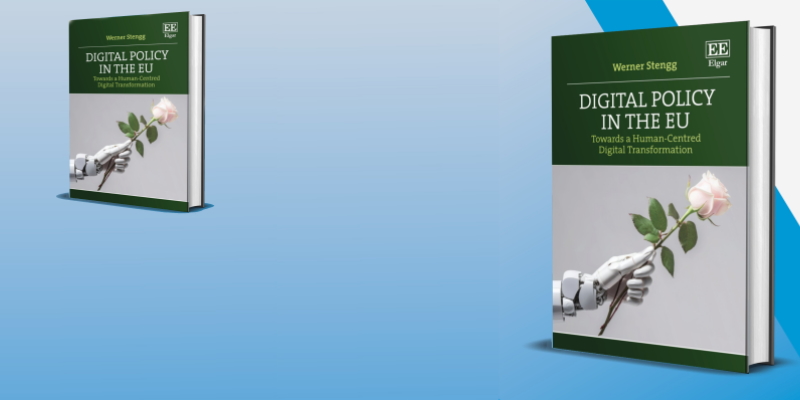Book review: Werner Stengg, Digital Policy in the EU. Towards a Human-Centred Digital Transformation
It is unusual to read an EU Commission insider’s writing on recent and current topics of legislation. Werner Stengg’s book Digital Policy in the EU is one of those unusual comments. Netopia invited a former Commission insider – Detlef Eckert – to review it.
Werner Stengg’s book Digital Policy in the EU. Towards a Human-Centred Digital Transformation (Edward Elgar Publishing 2024) addresses the EU’s response to the challenges posed by digital transformation. While it focuses predominantly on regulation, it also explores broader policy aspects.
Technology should serve people, not just businesses — a human-centred digital transformation
The subtitle reflects the EU’s perspective on technological disruption, emphasising the wish for technology to serve people rather than solely businesses. This aligns with the EU’s characteristic approach of pursuing three simultaneous objectives: social (human-centric), sustainability (climate), and competitiveness. Balancing these ambitions has always been challenging.
The increasing societal impact of social media, coupled with Meta’s recent scale-back of content moderation following similar actions by Twitter/X, makes Werner Stengg’s book particularly timely. While the book delves into various aspects of digital regulation, its analysis of Big Tech and social media regulation is especially compelling.
As an active EU official and a key figure within the Commission’s digital policy teams, Werner Stengg offers an insider’s perspective. Readers can expect a well-researched and meticulously drafted account of policy developments, providing valuable insight into how the Commission perceives digital technologies and the rationale behind its regulatory interventions.
The book’s stated aim is “to capture the digital transformation, as well as Europe’s policy response to it, in the most holistic way possible.”
SETTING THE SCENE
The author begins his book by examining the digital policy approach of the first von der Leyen Commission, which focused on the dual green-digital transformation. Its slogan, “Europe fit for the digital age,” encapsulated this vision. The text provides an overview of the evolution of the digital space, incorporating historical references and its connections to earlier scientific revolutions. The author briefly traces the development of the Internet, the World Wide Web (Sir Tim Berners-Lee, CERN), search engines, and mobile ecosystems.
Europe invents, the U.S. commercialises — a recurring pattern in tech history.
The chapter places significant emphasis on the platform economy, setting the stage for subsequent chapters by exploring the power of platforms and the regulations aimed at curbing this power. It identifies network effects, lack of transparency, disruption, and negative externalities as the most pressing challenges that require policy responses.
A Note on the Internet’s Evolution
I would like to take this opportunity to add a few comments regarding the evolution of the Internet. First, the Belgian software engineer Robert Cailliau, a colleague of Berners-Lee at CERN, should be recognised as a critical contributor to the project that became the World Wide Web. Second, it is a recurring pattern that technologies developed in Europe are commercialised in the United States.
Robert Cailliau deserves recognition as co-creator of the World Wide Web
For instance, the first commercially successful WWW browser was Netscape’s Navigator, which was pivotal in making eCommerce a reality. Third, the Internet was introduced to Europe on 17 November 1988, when the Dutch Computer Centrum CWI connected to the NSF. Interestingly, the European Commission, for a long time, did not embrace the TCP/IP suite but instead promoted ISO standards. Finally, the role of RIPE, the European IP registrar, in fostering internet adoption across Europe deserves greater recognition and appreciation.
REGULATING INTERNET-BASED SERVICES
In its third chapter, the book examines the first significant regulations aimed at internet services, or, as they are referred to, ‘information society services.’ This somewhat unusual term dates back to the 1990s when the EU’s digital strategy was built around the concept of the Information Society, introduced by Commissioner Martin Bangemann.
The eCommerce Directive stands out as a landmark regulation, establishing the principle of the country of origin for digital services combined with minimal regulatory requirements. Adopted in 2000, the Directive governed digital services for two decades and was considered an enabling framework that unleashed the potential of eCommerce. Its importance lies in its liability provisions for hosting, mere conduit, and caching services. While praised for fostering innovation, the Directive also attracted criticism.
Initially, hosting services were primarily databases and websites, but over time, they evolved into powerful platforms. The Directive aimed to limit “excessive litigation.” However, as the author recalls, critics argued that intermediaries could cause harm to others without being held accountable. Copyright holders were among those raising concerns, alongside those worried about harmful content that was inadequately moderated.
The author revisits these issues later in the book when discussing contemporary challenges and the Digital Services Act (DSA).
PRIVACY CONCERNS
The 1995 Data Protection Directive (which, by the way, took five years of negotiation) served as the cornerstone of privacy regulation in the EU. It formed the basis of the “Safe Harbour” arrangement with the US, later deemed legally insufficient by the European Court of Justice (ECJ).
However, the Directive had several shortcomings, which Werner Stengg explains in detail and which the General Data Protection Regulation (GDPR) addressed. For example, the GDPR clarified the definition of private data, outlined what constitutes valid consent, and provided a more comprehensive legal framework for data processing.
“Data processing must be lawful, fair, and transparent,” Stengg writes, highlighting the GDPR’s foundational principles. He elaborates on the principles of purpose limitation and data minimisation, raising essential questions about how these principles can be upheld in big data and artificial intelligence.
CONSUMER PROTECTION
In the context of eCommerce and digital services, the Commission has consistently regarded consumers as the weaker party needing protection. As the narrative explains, the Commission also recognised the importance of ensuring consumer trust in these new services to enable their adoption and growth.
Thus, consumer protection—much like privacy protection—has always been viewed as a means of safeguarding consumers and facilitating the development of digital services. This sub-chapter introduces various Directives and initiatives, providing detailed explanations of their provisions.
ALGORITHMS
Up to this point, the book has focused primarily on the consumer side. However, as the platform players’ market power increased, the focus shifted to competition policy. This shift began with several landmark competition cases and extended to the Platform-to-Business (B2B) Regulation, which aimed to address unfair competition. An informed reader will recognise that this development ultimately led to the Digital Markets Act (DMA), with a preparatory analysis presented in Chapter 4.
“The paradigm shift in European policymaking was the recognition that continued reliance on market forces alone would not solve any of the problems identified.” (p. 109)
Continued reliance on market forces alone won’t solve digital economy challenges.
In exploring these issues, the narrative revisits the earlier discussion of the platform economy, delving into market power, misaligned interests (negative externalities), information asymmetries, and unhealthy global dependencies. The author conducts a market failure analysis by examining the impact of the platform economy’s characteristics on markets. This offers valuable insight into how regulators perceive markets and rationalise regulation and market intervention.
Algorithm opacity is one of the Commission’s key concerns.
That said, the book could also have considered policy failure. Issues such as a lack of foresight, tendencies toward over-bureaucratisation, and slow responses to align regulation with dynamic market changes.
At this stage, the book clarifies that algorithm opacity is one of the Commission’s key concerns. These algorithms effectively govern how platforms operate, and their lack of transparency poses significant challenges for regulators.
TARGETS OF REGULATION
This section of the book helps the reader understand various regulatory approaches by distinguishing three partly overlapping characteristics.
First, specific regulations can be identified by their target services, such as video-sharing platforms or online marketplaces. Readers might be surprised to learn that several regulations were already in place even before the DSA and DMA were enacted.
Second, not every market player is subject to the same level of regulation. Typically, smaller companies benefit from exemptions or are regulated less. The book notes, “Therefore, it seems justified – and more proportionate – to request higher levels of due diligence from such large operators.” This distinction is evident in the DSA’s focus on “very large online platforms” and the DMA’s regulation of “gatekeepers” and “core platform services.”
Third, regulation can target specific technologies. While the EU traditionally follows a principle of technology neutrality, this approach appears to be shifting in certain policy areas, such as the Green Deal. The author refers to ‘data technology’ as an example of this focus. Another key example is artificial intelligence, which the AI Act addresses.
REGULATING DIGITAL MARKETS
After outlining various policy concepts related to the digital decade in Chapter 6, the narrative moves to the core of the book, focusing on the most recent legislative initiatives, starting with the Digital Markets Act (DMA).
“…the new digital monopolies (or oligopolies) were the result of the free play of market forces: …”.
The central issue addressed is the weak contestability of specific digital markets. One earlier attempt to address this was the Platform-to-Business Regulation, which aimed to enhance transparency but ultimately fell short of making digital markets fair and contestable.
The author identifies five factors that contribute to market contestability: ease of market entry, access to market information, absence of self-preferencing, avoidance of lock-in situations, and limiting the leveraging of market power into adjacent markets. The DMA directly addresses these concerns, which the author analyses before moving on to the Digital Services Act (DSA).
For some, the DSA is too weak; for others, it goes too far, curtailing free speech. The book offers a balanced perspective, helping to rationalise the debate by clarifying what the DSA
The author turns to the DSA to explain how it distinguishes between social media platforms and eCommerce marketplaces. While the liability regime remains unchanged, the DSA introduces day-to-day responsibilities and due diligence requirements. It defines the processes that intermediaries or platforms must follow to mitigate risks.
Chapter 8 takes on a more political topic: democracy and social media. The chapter reveals how Elon Musk’s decision to reduce or even remove content moderation on X has struck a nerve with EU policymakers. The book illustrates their unease about these developments, which is evident in recent European statements regarding Musk’s actions. For some, the DSA is too weak; for others, it goes too far, curtailing free speech. The book offers a balanced perspective, helping to rationalise the debate by clarifying what the DSA does and does not address. Beneficial are the two summarised sections outlining the key aspects of the DSA.
THE BROADER REGULATORY LANDSCAPE
In Chapter 9, Werner Stengg introduces the reader to several initiatives, including those related to data governance, cybersecurity, the Chips Act, and, most notably, artificial intelligence (AI). This provides an overview of the broad range of regulations and initiatives impacting various aspects of the digital economy. AI has become a politically charged topic, and the book explains the rationale behind the AI Act. It also covers the various political discussions and formats, such as the G7, that have taken place.
Given the rapid advancements in generative AI (foundation models), the onset of the Trump administration, and the substantial investments announced in the US and China, the European response appears cautious (despite strong political statements and recent announcements). It will be fascinating to revisit this topic in a few years to see how market realities have unfolded compared to the current discussions.
CONCLUSIONS
Is Europe fit for the digital age?
Werner Stengg’s book comprehensively explores the EU’s digital policy, shedding light on the motivations and challenges underlying its regulatory framework. The author ultimately leaves readers with the question: Is Europe fit for the digital age? This question is accompanied by ten key takeaways encapsulating the book’s insights. I conclude this review by inviting readers to delve into these takeaways for themselves and explore Stengg’s analysis.


